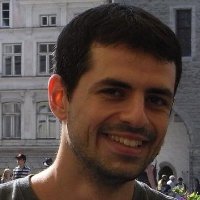Natural Language Processing
for Intelligent Access
to Scientific Information
#NLP4scipub on TwitterTweet #NLP4scipub
on December 11th 2016 from 14:00 to 17:00
Natural Language Processing Group
Department of Information and Communication Technologies, Universitat Pompeu Fabra, Barcelona
Introduction
Go top
During the last decade the amount of scientific information
available on-line increased at an unprecedented rate. Recent estimates reported that a new paper is published every 20 seconds.
As a consequence, nowadays researchers are overwhelmed by an
enormous and continuously growing number of articles to consider
when they perform any activity that requires a careful and comprehensive
assessment of scientific literature, like the exploration of
advances in specific topics, peer reviewing, writing and
evaluation of proposals.
Natural Language Processing Technology represents a key enabling factor in providing scientists with intelligent patterns to access to scientific information. Extracting information from scientific papers, for example, can contribute to the development of rich scientific knowledge bases which can be leveraged to support intelligent knowledge access and question answering. Summarization techniques can reduce the size of long papers to their essential content or automatically generate state-of-the-art-reviews. Paraphrase or textual entailment techniques can contribute to the identification of relations across different scientific textual sources. This tutorial provides an overview of the most relevant tasks related to the processing of scientific documents, including but not limited to the in-depth analysis of the structure of the scientific articles, their semantic interpretation, content extraction and summarization.
Topics
Go topHere there is a list of some of the core topics that will be presented during the tutorial:
- Scientific information overload: challenges and opportunities
- Mining the structure of scientific publications: PDF files and XML data formats
- The semantics of papers: scientific discourse and citation analysis
- Extracting information from scientific publications
- Scientific document summarization
- Language resources for scientific text mining
- Social Media and Science: new opportunities
- Scientific text mining projects, portals and challenges
- Hands-on demo of the Dr. Inventor Text Mining Framework
Presenters
Go top Horacio Saggion holds a PhD in Computer Science from Universite de Montreal, Canada. He obtained his BSc in Computer Science from Universidad de Buenos Aires in Argentina, and his MSc in Computer Science from UNICAMP in Brazil. Horacio is an Associate Professor at the Department of Information and Communication Technologies, Universitat Pompeu Fabra (UPF), Barcelona. He is a member of the Natural Language Processing group where he works on automatic text summarization, text simplification, information extraction, sentiment analysis and related topics. His research is empirical combining symbolic, pattern-based approaches and statistical and machine learning techniques. Before joining Universitat Pompeu Fabra, he worked at the University of Sheffield for a number of UK and European research projects (SOCIS, MUMIS, MUSING, GATE, CUBREPORTER) developing competitive human language technology. He was also an invited researcher at John Hopkins University for a project on multilingual text summarization. He is currently principal investigator for UPF in several EU and national projects.
Horacio has published over 100 works in leading scientific journals, conferences, and books in the field of human language technology. He organized four international workshops in the areas of text summarization and information extraction and was co-chair of STIL 2009. He is co-editor of a book on multilingual, multisource information extraction and summarization published by Springer in 2013. Horacio is member of the ACL, IEEE, ACM, and SADIO. He is a regular programme committee member for international conferences such as ACL, EACL, COLING, EMNLP, IJCNLP, IJCAI and is an active reviewer for international journals in computer science, information processing, and human language technology. Horacio has given courses, tutorials, and invited talks at a number of international events including LREC, ESSLLI, IJCNLP, NLDB, and RuSSIR.
Horacio Saggion holds a PhD in Computer Science from Universite de Montreal, Canada. He obtained his BSc in Computer Science from Universidad de Buenos Aires in Argentina, and his MSc in Computer Science from UNICAMP in Brazil. Horacio is an Associate Professor at the Department of Information and Communication Technologies, Universitat Pompeu Fabra (UPF), Barcelona. He is a member of the Natural Language Processing group where he works on automatic text summarization, text simplification, information extraction, sentiment analysis and related topics. His research is empirical combining symbolic, pattern-based approaches and statistical and machine learning techniques. Before joining Universitat Pompeu Fabra, he worked at the University of Sheffield for a number of UK and European research projects (SOCIS, MUMIS, MUSING, GATE, CUBREPORTER) developing competitive human language technology. He was also an invited researcher at John Hopkins University for a project on multilingual text summarization. He is currently principal investigator for UPF in several EU and national projects.
Horacio has published over 100 works in leading scientific journals, conferences, and books in the field of human language technology. He organized four international workshops in the areas of text summarization and information extraction and was co-chair of STIL 2009. He is co-editor of a book on multilingual, multisource information extraction and summarization published by Springer in 2013. Horacio is member of the ACL, IEEE, ACM, and SADIO. He is a regular programme committee member for international conferences such as ACL, EACL, COLING, EMNLP, IJCNLP, IJCAI and is an active reviewer for international journals in computer science, information processing, and human language technology. Horacio has given courses, tutorials, and invited talks at a number of international events including LREC, ESSLLI, IJCNLP, NLDB, and RuSSIR.
 Francesco Ronzano holds a PhD in Information
Engineering from the University of Pisa, Italy. Francesco is
currently a Researcher of the Natural Language Processing Group
(TALN) at the Department of Information and Communication
Technologies, Universitat Pompeu Fabra, Barcelona, where he deals
with machine learning approaches for information extraction and
text summarization, with special focus on scientific publishing and
social media analysis. Francesco has several years of research
experience mainly in the context of National (Italian and Spanish)
and European Research Projects related to the exploitation of
machine learning approaches and Web technologies to foster Language
Technologies. His research interests include on-line data
semantics, machine learning, knowledge representation and Semantic
Web applications.
Francesco Ronzano holds a PhD in Information
Engineering from the University of Pisa, Italy. Francesco is
currently a Researcher of the Natural Language Processing Group
(TALN) at the Department of Information and Communication
Technologies, Universitat Pompeu Fabra, Barcelona, where he deals
with machine learning approaches for information extraction and
text summarization, with special focus on scientific publishing and
social media analysis. Francesco has several years of research
experience mainly in the context of National (Italian and Spanish)
and European Research Projects related to the exploitation of
machine learning approaches and Web technologies to foster Language
Technologies. His research interests include on-line data
semantics, machine learning, knowledge representation and Semantic
Web applications.Francesco has contributed to more than 40 publications among book chapters, journal articles, conference papers. He acted as reviewer to international conferences including AAAI, EMNLP, LREC, RANLP, etc.
References
Go top- Mario Lipinski, Kevin Yao, Corinna Breitinger, Joeran Beel, and Bela Gipp. 2013. Evaluation of header metadata extraction approaches and tools for scientific pdf documents. In Proceedings of the 13th ACM/IEEE-CS joint conference on Digital libraries, pages 385–386. ACM.
- Patrice Lopez. 2009. Grobid: Combining automatic bibliographic data recognition and term extraction for scholarship publications. In International Conference on Theory and Practice of Digital Libraries, pages 473–474. Springer.
- Alexandru Constantin, Steve Pettifer, and Andrei Voronkov. 2013. Pdfx: fully-automated pdf-to-xml conversion of scientific literature. In Proceedings of the 2013 ACM symposium on Document engineering, pages 177–180. ACM.
- Isaac G Councill, C Lee Giles, and Min-Yen Kan. 2008. Parscit: an open-source crf reference string parsing package. In LREC, volume 8, pages 661–667.
- Cartic Ramakrishnan, Abhishek Patnia, Eduard Hovy, and Gully APC Burns. 2012. Layout-aware text extraction from full-text pdf of scientific articles. Source code for biology and medicine, 7(1):1.
- Minh-Thang Luong, Thuy Dung Nguyen, and Min-Yen Kan. 2012. Logical structure recovery in scholarly articles with rich document features. Multimedia Storage and Retrieval Innovations for Digital Library Systems, 270.
- Francesco Ronzano and Horacio Saggion. 2016. Knowledge extraction and modeling from scientific publications. In Semantics, Analytics, Visualisation: Enhancing Scholarly Data Workshop co-located with the 25th International World Wide Web Conference.
- Amjad Abu-Jbara, Jefferson Ezra, and Dragomir R Radev. 2013. Purpose and polarity of citation: Towards NLP-based bibliometrics. In HLT-NAACL, pages 596–606.
- Awais Athar. 2011. Sentiment analysis of citations using sentence structure-based features. In Proceedings of the ACL 2011 student session, pages 81–87. Association for Computational Linguistics.
- Stefanie Haustein, Vincent Larivi`ere, Mike Thelwall, Didier Amyot, and Isabella Peters. 2014. Tweets vs. Mendeley readers: How do these two social media metrics differ? IT-Information Technology, 56(5):207–215.
- Mike Thelwall, Stefanie Haustein, Vincent Larivière, and Cassidy R Sugimoto. 2013. Do altmetrics work? twitter and ten other social web services. PloS one, 8(5):e64841.
- Judit Bar-Ilan, Stefanie Haustein, Isabella Peters, Jason Priem, Hadas Shema, and Jens Terliesner. 2012. Beyond citations: Scholars’ visibility on the social web. arXiv preprint arXiv:1205.5611.
- Bo-Christer Bj ork, Mikael Laakso, Patrik Welling, and Patrik Paetau. 2014. Anatomy of green open access. Journal of the Association for Information Science and Technology, 65(2):237–250.
- David W Lewis. 2012. The inevitability of open access. College & Research Libraries, 73(5):493–506.
- Randall Munroe. The Rise of Open Access Science 04 Oct 2013: Vol. 342, Issue 6154, pp. 58-59 DOI: 10.1126/science.342.6154.58
- Beatriz Fisas, Francesco Ronzano, and Horacio Saggion. 2015. On the discoursive structure of computer graphics research papers. In The 9th Linguistic Annotation Workshop held in conjuncion with NAACL 2015, page 42.
- Yufan Guo, Anna Korhonen, and Thierry Poibeau. 2011. A weakly-supervised approach to argumentative zoning of scientific documents. In Proceedings of the Conference on Empirical Methods in Natural Language Processing, pages 273–283. Association for Computational Linguistics.
- Maria Liakata, Simone Teufel, Advaith Siddharthan, Colin R Batchelor, et al. 2010. Corpora for the conceptualisation and zoning of scientific papers. In LREC.
- Simone Teufel, Advaith Siddharthan, and Colin Batchelor. 2009. Towards discipline-independent argumentative zoning: evidence from chemistry and computational linguistics. In Proceedings of the 2009 Conference on Empirical Methods in Natural Language Processing: Volume 3-Volume 3, pages 1493–1502. Association for Computational Linguistics.
- Qi He, Jian Pei, Daniel Kifer, Prasenjit Mitra, and Lee Giles. 2010. Context-aware citation recommendation. In Proceedings of the 19th international conference on World wide web, pages 421–430. ACM.
- Wenyi Huang, Saurabh Kataria, Cornelia Caragea, Prasenjit Mitra, C Lee Giles, and Lior Rokach. 2012. Recommending citations: translating papers into references. In Proceedings of the 21st ACM international conference on Information and knowledge management, pages 1910–1914. ACM.
- Amjad Abu-Jbara and Dragomir Radev. 2011.
Coherent citation-based summarization of scientific papers. Proc. of 49th Annual Meeting of the ACL: Human Language Techologies, pages 500–509. ACL, June. - Simone Teufel and Marc Moens. 2002. Summarizing scientific articles: experiments with relevance and rhetorical status. Computational linguistics, 28(4):409–445.
- Francesco Ronzano and Horacio Saggion. 2016. An empirical assessment of citation information in scientific summarization. In International Conference on Applications of Natural Language to Information Systems, pages 318–325. Springer.
- Horacio Saggion. 2008. SUMMA: A Robust and Adaptable Text Summarization Tool In TAL 49(2): pp103-125.
- Joan Codina-Filba, Nadjet Bouayad-Agha, Alicia Burga, Gerard Casamayor, Simon Mille, Andreas Muller, Horacio Saggion, Leo Wanner. 2017. Using genre-specific features for patent summaries. In Inf. Process. Manage. 53(1): pp151-174.
- Dragomir R. Radev, Timothy Allison, Sasha Blair-Goldensohn, John Blitzer, Arda Celebi, Stanko Dimitrov, Elliott Drabek, Ali Hakim, Wai Lam, Danyu Liu, Jahna Otterbacher, Hong Qi, Horacio Saggion, Simone Teufel, Michael Topper, Adam Winkel, Zhu Zhang:. 2004. MEAD - A Platform for Multidocument Multilingual Text Summarization. In Proceedings of LREC 2004.